The Ghost City of Herculaneum: between beauty and history
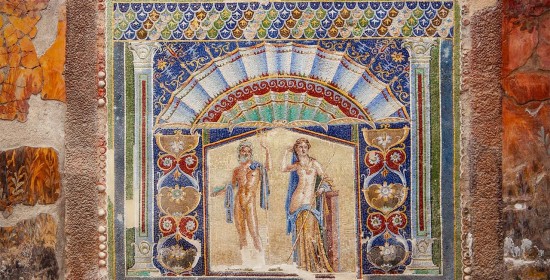
Buongiorno and welcome to Stefano’s RomeCabs, Rome’s leading company for private tours in Italy. We’ve taken our guests on our Private Day Tour from Rome to Herculaneum for many years along with visits to Sorrento and Amalfi Coast.
We wish to introduce you to Herculaneum (or Ercolano in Italian) which offers a magnificent glimpse into the daily life of this once thriving opulent Ancient Roman resort city that was destroyed by Mount Vesuvius in 79 AD and entombed into perpetuity.
In this article, we will also cover these top frequently asked questions about Herculaneum:
- Why is Pompeii more famous than Herculaneum?
- The fascinating ancient history of Herculaneum
- How did Herculaneum get its name?
- What was Herculaneum like before its destruction?
- Herculaneum, the seaside resort of wealthy Romans
- What caused the destruction of the city of Herculaneum in 79 AD?
- What happened to the citizens of Herculaneum?
- How was Herculaneum discovered?
- Why is Herculaneum better preserved than Pompeii?
- Takeaway: is it worth visiting Herculaneum on a tour from Rome to Amalfi Coast?
The Ghost City of Herculaneum: between beauty and history
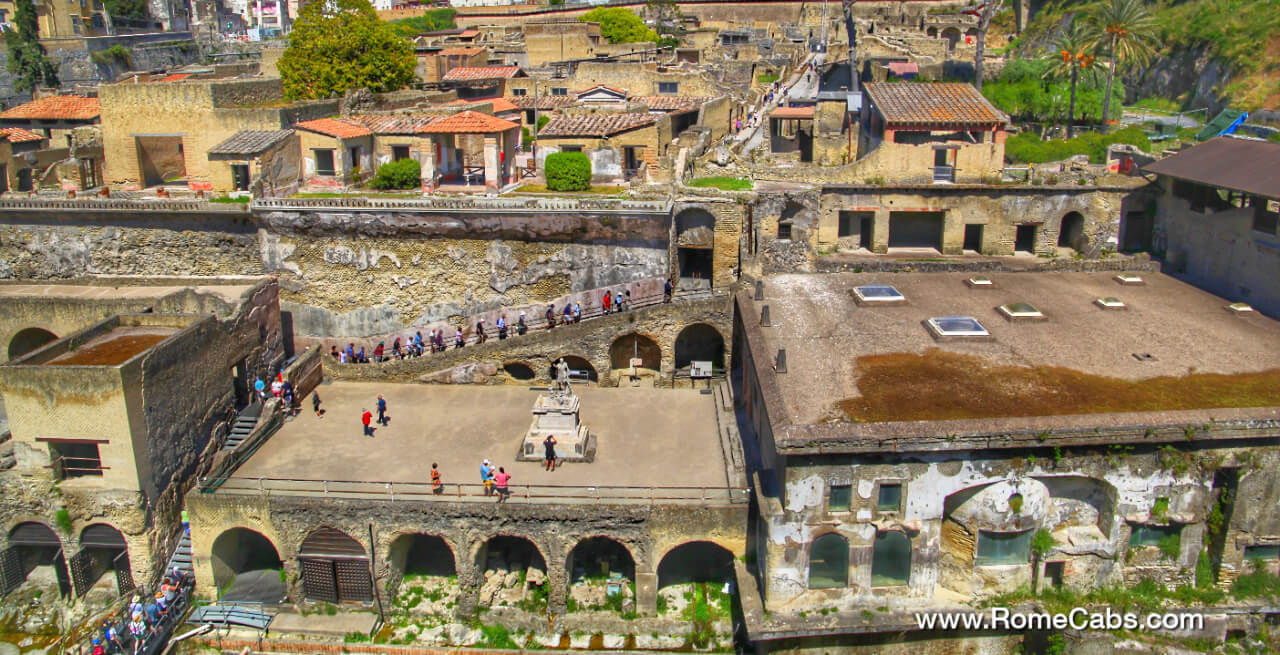
1. Why is Pompeii more famous than Herculaneum?
Herculaneum is generally overlooked in favor of the bigger and more famous Pompeii. While 2.5 million tourists visit Pompeii each year, only about 300,000 visitors make their way to the smaller Herculaneum. At about 50 acres, Herculaneum is smaller than Pompeii which covers about 110 acres. Naturally, the larger the archaeological site, the more ruins are available to see.
It's true that on our day tours from Rome to Amalfi Coast and shore excursions from Naples most of our clients choose to visit Pompeii. Pompeii is the famous big sister who's always in the limelight, and Herculaneum is the little sibling that goes unnoticed in spite of its magnificence.
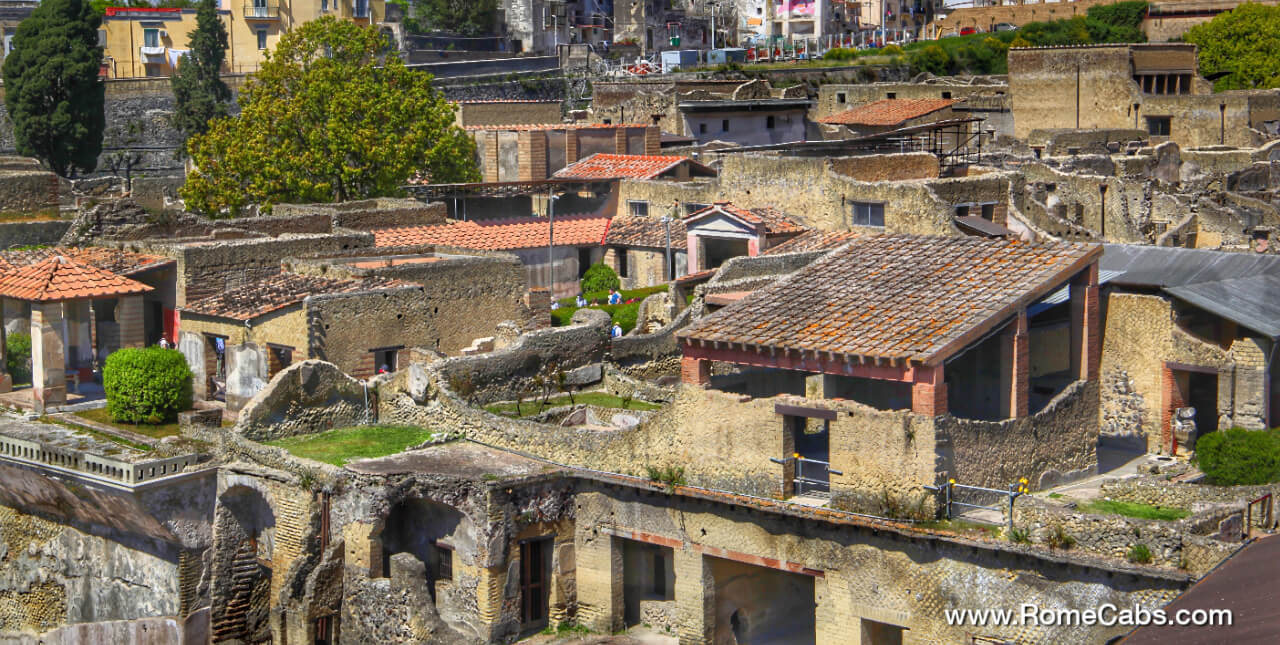
Pompeii was the first site to be excavated in the late 16th century by architect Domenico Fontana giving it a head start. In the meanwhile, Herculaneum was discovered in 1709 and excavations began in 1738.
Pompeii was the first to garner international attention inspiring some of the world’s most illustrious writers of the 18th-19th century such as the German poet Goethe and American writer Mark Twain to visit Pompeii and write about it. While Pompeii was gaining fame internationally, Herculaneum was still unheard of.
You could surmise that Pompeii had a head start in being discovered, was better marketed, and it’s much bigger in size. And no wonder our Pompeii, Sorrento, and Amalfi Coast tour from Rome is one of our most frequently requested tours. The good news is that more and more people are discovering the very impressive Herculaneum that's gaining more and more popularity with travelers who wish to experience the lesser touristy sites in Italy and enjoy cultural enrichment.
2. The fascinating ancient history of Herculaneum
The founding of Herculaneum is about as fascinating as its demise. Like so many prominent cities in Italy, Herculaneum is quite ancient and shrouded in legends.
Herculaneum was founded between the 6th-7th century BC by the Oscans, an ancient Italic people that settled in the regions of Campania and Latium during the Roman times. Eventually, Herculaneum changed hands as different civilizations rose and fell.
After the Oscans, the Etruscans dominated this region and made the most of Herculaneum’s coastal location increasing trade. By the 5th century, BC Herculaneum became subject to Greeks who founded their own “New City” Neapoli (which later became Naples). By the 4th century BC Herculaneum was dominated by the Samnites, and in 89 BC became a Roman municipium.
Mount Vesuvius played an important role in both Herculaneum’s birth and demise. Herculaneum was built on a promontory by the sea formed from prior Vesuvius eruptions. This location made Herculaneum easily defendable. The sea provided excellent fishing, the fertile volcanic soil enhanced agriculture, and tuff stones provided materials for construction. Herculaneum also prospered as a stopping point between Pompeii and Neapolis. Each settling civilization left its mark on Herculaneum in some fashion.
Facing the sea contributed to Herculaneum becoming a seaside resort when it became a Roman municipum (municipal) offering opulent summer retreats for the Roman elites wishing to escape the stifling summer heat of Rome.
3. How did Herculaneum get its name?
It’s apparent even at a glance that Herculaneum was given its name in honor of the Greek mythical demigod Heracles (Hercules in the Roman mythology), another indication of the Greek influence on this settlement. The Greeks named this settlement Heraklion (Ἡράκλειον), and it served as an attractive post due to its proximity to the Gulf of Naples.
According to legends, the city was founded by Hercules as he passed through the Italian peninsula from his home in Iberia to secure the herd of Geryones during this 10th labor. Some legends claim Hercules fought flaming giants in the same area, possibly incorporating the eruptions of Mount Vesuvius into mythology.
Even the pre-Roman Etruscan civilization venerated Hercle. Both Etruscans and Romans adapted Greek myths into their own mythologies and religions.
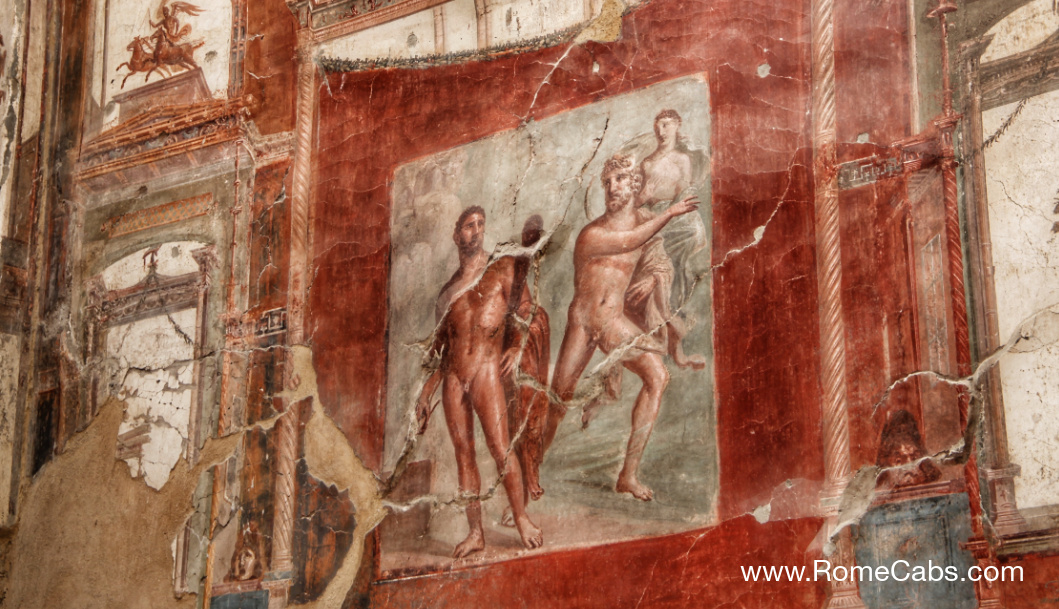
The Romans venerated Hercules and even integrated this mythological figure into the legend of Rome’s founding creating a profound symbolic connection with their beloved hero-god. Rome’s mythological tradition places Hercules in Rome during his 10th labor when he stole the cattle of Geryon in the far west and drove them through the Italian peninsula. Rome’s Forum Boarium (Cattle Market) was aptly named after Hercule’s feat, and the round Temple of Hercules Victor still stands in Piazza Bocca della Verita in Rome.
4. What was Herculaneum like before its destruction?
Herculaneum can be described as a time capsule of ancient Roman life. As you meander along the stone roads of this ancient ghost city, you can almost “see” and “hear” the vibrant life that once thrived in this captivating ancient city.
As with most ancient Roman cities, daily life in Herculaneum rose and fell by the rhythm of the sun around which life evolved. By sunrise, locals were already up and about their daily business and activities.
Bakeries (Pistrinium) and eateries (thermopolium) gave off the appetizing scent of the food they baked and cooked. The marketplace was bustling with a burst of colorful togas, tunics, and robes of vendors selling their wares and locals shopping the stalls.
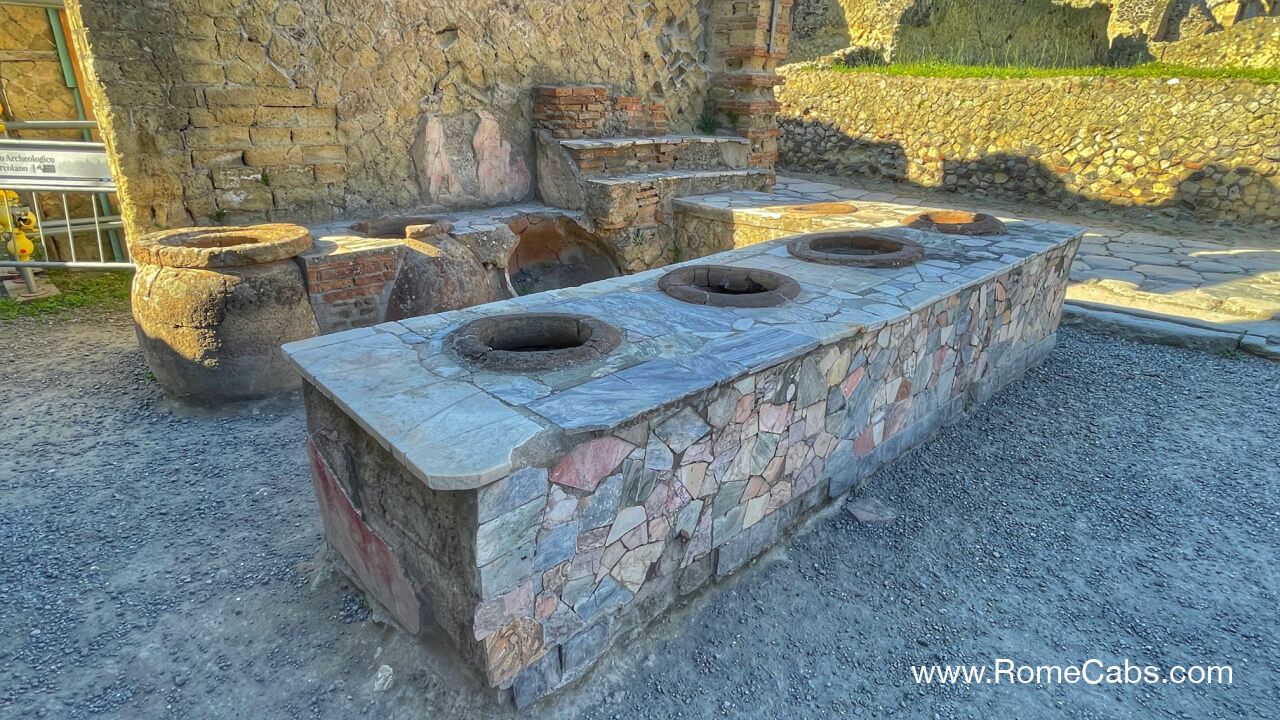
Local men wore simple togas which were loose robes fashioned from a single sheet of cloth draping loosely around the body. Local city folk traditionally wore white, while the upper class wore colors such as purple. Women wore colorful stolas which were sleeveless tunics that draped loosely from their shoulders.
In the afternoons, local baths and therapeutic spas were frequented by the locals as bathing was considered a social activity. Two public baths (thermae) were discovered so far in Herculaneum.
Herculaneum boasted all the facilities of a wealthy Roman town: a forum, a basilica (or an ancient Roman tribunal), an aqueduct for public fountains (the city was connected to the Serino aqueduct which was built in the Augustan age), a drainage and sewage system, a theater, baths, palaestra (gymnasium), shops, necropolises - many of which are still buried underground.
The streets of Herculaneum appear to lack a lot of traffic as they are not as worn out as the streets in Pompeii. Herculaneum demonstrates a contemporary looking grid-like urban planning dividing the city into city blocks. The town had at least three Decumani (north-south streets) that intersected by five perpendicular Cardi (east-west streets).
In Herculaneum, there were various types of housing from large villas to smaller townhouses with second-floor balconies, and city apartment blocks (insulae).
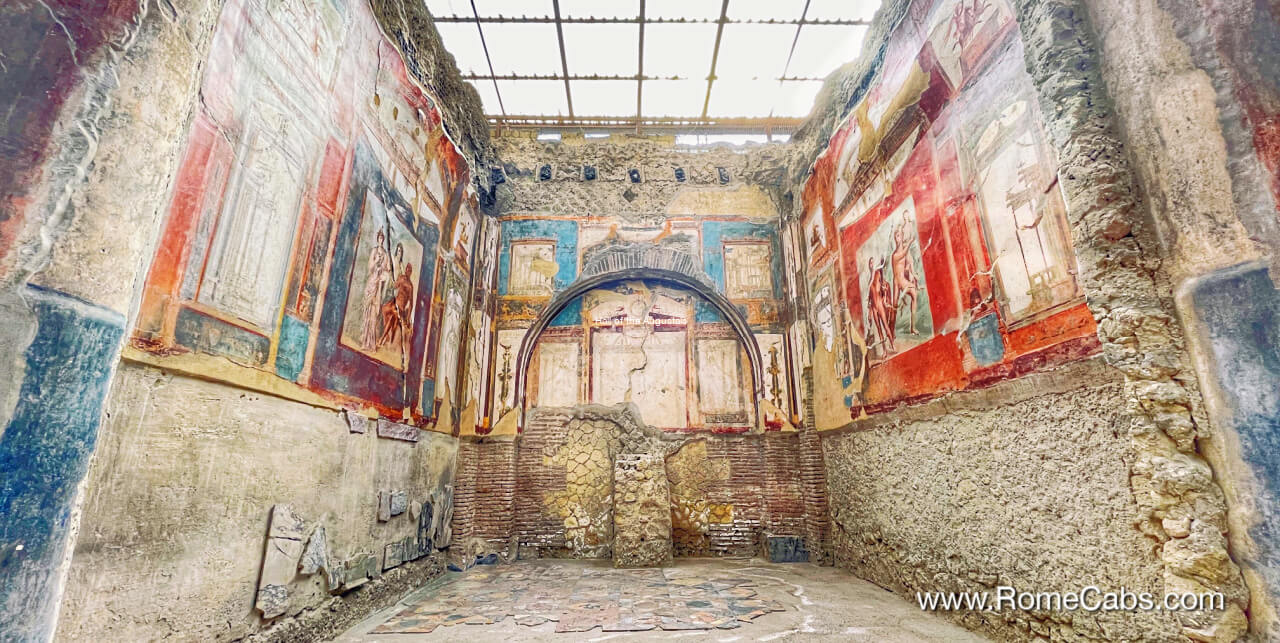
The wealth of some of Herculaneum's residents in 1st-century AD is evident by the presence of many impressive villas that boasted exquisitely frescoed walls, ornate mosaics, central pools, refined atriums, terraced gardens, gorgeous statues, fountains, and panoramic sea views. Many such grand residences have shops built right into their facades that obscure the opulence that exists within.
5. Herculaneum, the seaside resort of wealthy Romans
Herculaneum traded with its neighboring cities and made good use of its small harbor but due to its limited land, it could never grow and expand to a large city comparable to Pompeii or Neapolis. And that was perfectly fine as Herculaneum’s significance to the Romans was one of pleasure, not business as with Pompeii.
Perhaps being a smaller town made it more attractive to wealthier Roman citizens who came to Herculaneum for its quieter atmosphere, fine weather, and picturesque sea views turning this small city into a fine summer seaside resort.
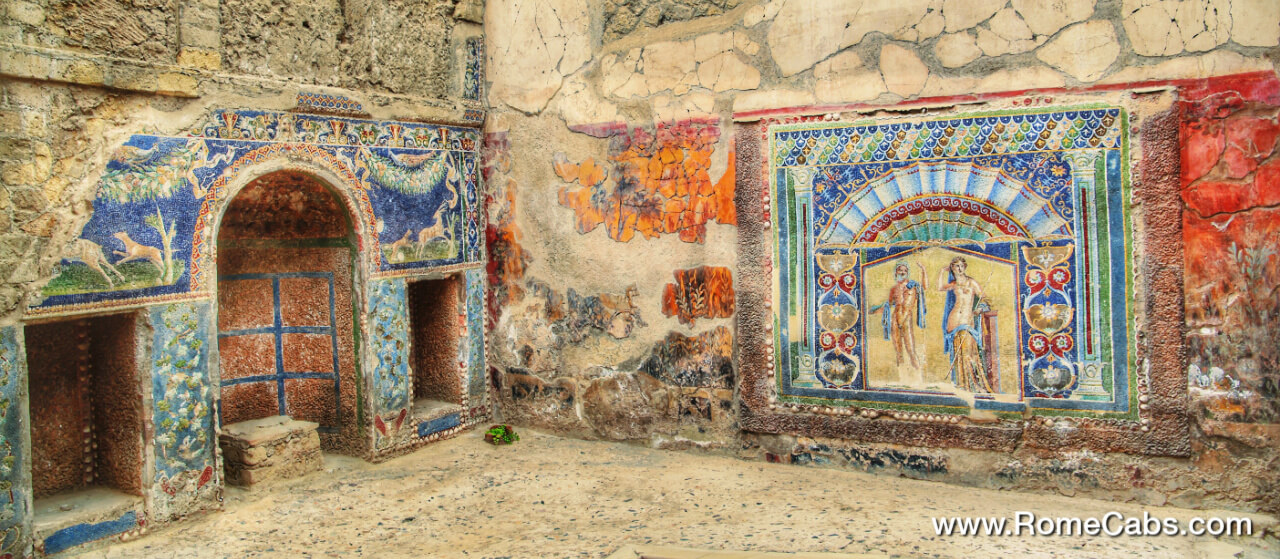
Among the Roman elites who had a country retreat in Herculaneum was consul Appius Claudius Pulcher. The city’s most famous villas, The Villa of the Papyri, belonged to the former politician, philosopher, and father-in-law of Julius Caesar, Lucius Calpurnius Piso Caesoninus.
6. What did people in Herculaneum eat?
Researchers led by the University of York discovered that the men and women of Herculaneum at different according to their gender. For example, men consumed more fish and seafood (considered luxury items) as well as grains.
Men had more access to seafood as they were more likely directly engaged in fishing activities. Men also held more prestigious positions in society that afforded them greater access to costlier commodities such as fresh fish and seafood. Women appeared to have consumed more meat, eggs, dairy, fruits, and vegetables.
6. What caused the destruction of the city of Herculaneum in 79 AD?
On February, 62 AD Herculaneum - along with Pompeii - suffered from a strong earthquake in that measured 7.5 on the Richter scale. Its damaged buildings have not yet been repaired by the time Mount Vesuvius erupted due to aftershocks and smaller quakes that continued to cause damage.
When Vesuvius finally erupted between August and September of 79 AD, Herculaneum experienced two stages of volcanic eruption.
In the first phase, an enormous column of volcanic ash and rocks exploded high into the air before falling back down to the ground like rain. Because the wind blew in a southeast direction, this rain of pumice and ash fell primarily over Pompeii, injuring the inhabitants or trapping them inside buildings, causing other buildings to collapse under the weight, and burying the city. Herculaneum was not initially impacted by this phase, potentially allowing many inhabitants to escape before the second destructive phase began.
Unfortunately, their fate dramatically changed by nighttime when the second destructive phase of superheated pyroclastic flows of molten rock and surges of intense 400 degrees Celcius gases that had no oxygen in it cascaded down the volcano at a dramatic speed of 100 kph swallowing Herculaneum and killing everything in its path to the point of evaporating them. The infernal surge was so hot it carbonized wood in the city and caused the sea to boil when it reached the waterfront.
While it took 3 days to destroy Pompeii, Herculaneum was destroyed in roughly 2 hours.
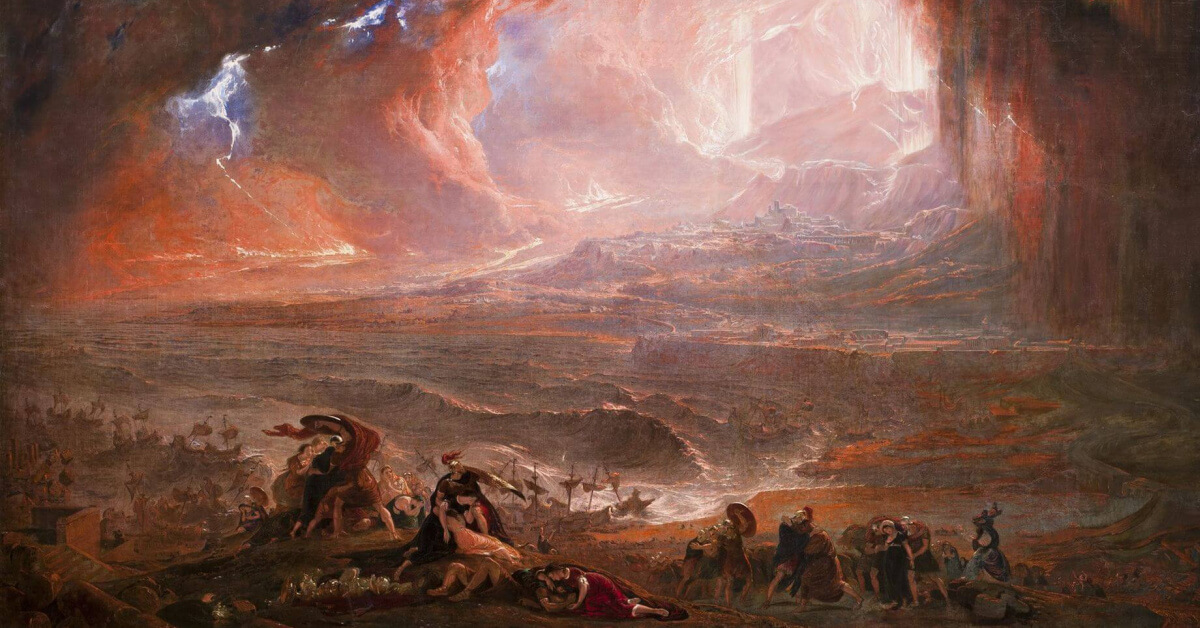
Avalanches of thick liquid followed, covering the city with a 25-meter thick of volcanic mud that also slid into the harbor, extending the coastline away from the city. Herculaneum fell silent and ceased to exist. This mudslide hardened to form a tufa rock that entombed Herculaneum suspending it in time, both destroying it and preserving it for 2,000 years.
The memory of Herculaneum faded and was lost to legends and myths until it was rediscovered centuries later. It was this vast amount of hardened volcanic material that also preserved the ruins of Herculaneum better than Pompeii and concealed it from looters and treasure hunters.
7. What happened to the citizens of Herculaneum?
In Pompeii, the human casts tell us the tragic story of how many Pompeiians died from Vesuvius’ violent eruption trapped and buried by falling stones and pumice. However, since few human remains were found during early excavations in Herculaneum, archaeologists believed that the residents escaped the volcano’s wrath.
However, during the 1980s and 1990s, excavations unearthed well-preserved skeletons of roughly 300 victims who perished at the harbor trying to escape Vesuvius’ inferno by seeking shelter inside brick boathouses and sheds. Perhaps they were waiting for boats and vessels to rescue them.
Their scorched remains indicate that they had been incinerated in the pyroclastic flows at such high temperature that their bodies were instantly vaporized, leaving only their skeletons behind as evidence of their existence. Some of the discovered skeletons are housed at the Museum of Anthropology in Naples.
Even though 2,000 years have passed since Herculaneum was obliterated and buried deep in volcanic rock, skeletal remains help us understand our past by revealing secrets about the victims’ ancient lives from their age to their health status, diet, and livelihoods.
We learned that, in general, the population of Herculaneum had healthy teeth, and people were taller than the modern-day Neapolitans. Children grew at a slower rate than contemporary humans and had a greater genetic diversity than the children of Pompeii. People performed heavy physical labor from childhood, and Arthritis was apparent in about 42% of the population, along with signs of recovery from various ailments from anemia to rickets. As detailed above, we also learned about their diet.
8. How was Herculaneum discovered?
The violent eruption of Mount Vesuvius submerged Herculaneum approximately 5 times the amount of ash that covered Pompeii which made Herculaneum’s discovery more difficult.
After 17 centuries of being buried underground and lost to time and stories of antiquity, Herculaneum was discovered by accident in the early 1700s. While digging a well, a wall was discovered that was later determined to have been part of a theater. In no time, treasure hunters began digging tunnels and retrieving artifacts.
Under the patronage of the King of Naples and the direction of Karl Weber, excavations of Herculaneum began in 1750 and lasted until 1764. During this time exciting artifacts were discovered and documented ranging from paintings and statues to bronze and marble works of art. In 1823 excavation resumed utilizing methods such as working from the above-ground instead of tunneling which was already employed successfully in Pompeii.
Remarkably, the discovery of the Herculaneum has helped us discover more about life in this ancient city of Rome.
Among the most significant discoveries in Herculaneum was a library of thousands of ancient papyri scrolls recovered from the luxurious Villa of the Papyri. Although this discovery was initially made in 1750, it took centuries for science and technology to arrive that may allow us to gain access into the world and thoughts of ancient civilizations that have been inaccessible to us for centuries.
Multi-spectral imaging (a technique developed in the 1990s) along with Micro CT scanners, X-rays, and computer science help digitally unroll the scrolls hopefully making reading the fragile burnt papyri scrolls possible. Most of the scrolls recovered thus far are Epicurean philosophical texts written by Philodemus of Gadara (a Syrian Epicurean philosopher and poet) with prose and poetry that had been lost to modern scholars until the discovery of this extraordinary ancient library.
Epicurus was a 3rd century BC Greek philosopher who developed a school of thought that promoted pleasure as life’s main goal, but in the form of modest living, learning about the natural world, and relinquishing fear of the afterlife.
9. Why is Herculaneum better preserved than Pompeii?
When you visit Herculaneum, you can’t help but notice how this ancient ghost city appears better preserved than Pompeii: more buildings intact, exquisite frescoes in near perfect condition… even remains of wooden furniture and materials.
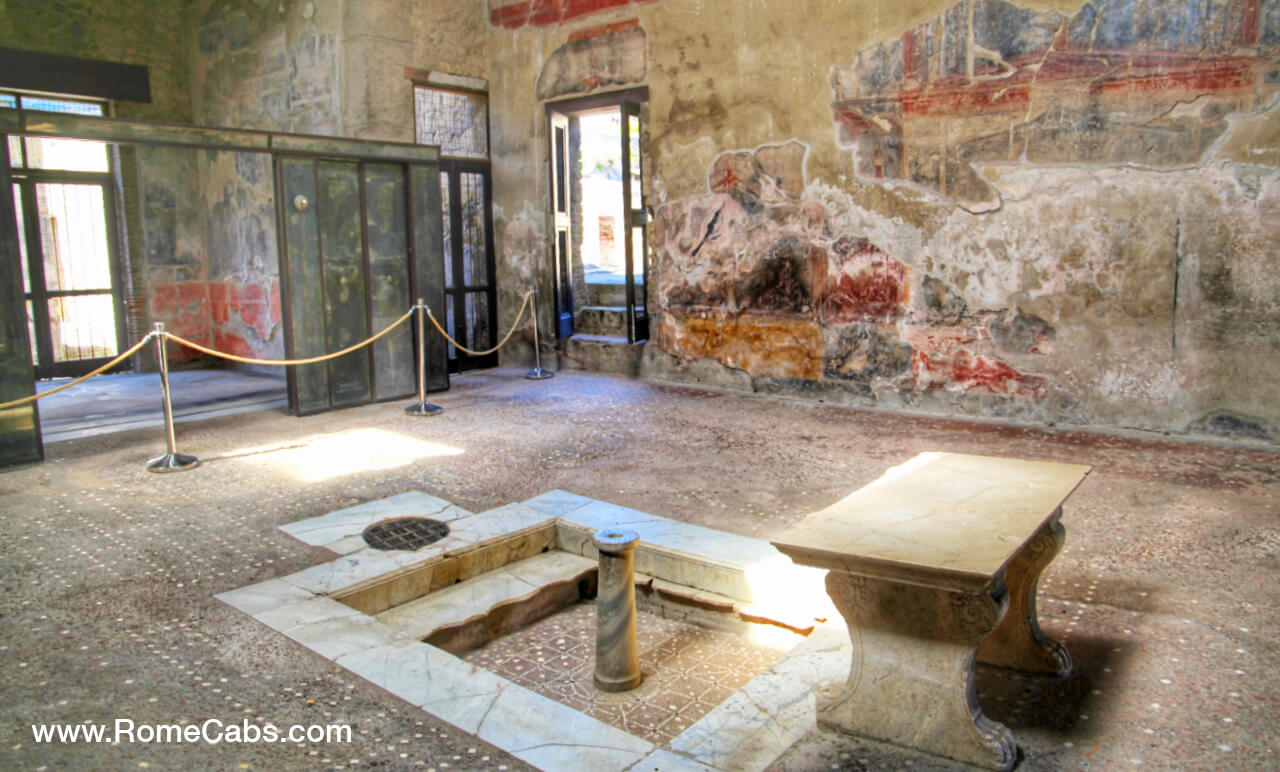
Some argue that Herculaneum is not essentially better preserved, but preserved differently than Pompeii based on how they each experienced the eruption of Mount Vesuvius. For starters, Pompeii was covered by ash and stone, while Herculaneum was covered by pyroclastic materials and mud that solidified into tufaceous rock, preserving even organic material and upper stories of buildings. Herculaneum is even more difficult to excavate than Pompeii, which limited the opportunities for looting, tampering, and vandalism.
These particular conditions between ground humidity and being sealed in stone made it possible for organic objects like wooden furniture, cupboards, textiles, and even food (such as carbonized loaves of bread) to be conserved and protected. As a result of this, Herculaneum appears better preserved with important details that offer us a rare glimpse into this lost Roman world frozen in time since the 1st century AD.
10. Is it worth visiting Herculaneum from Rome on a tour to Amalfi Coast?
Whether you are thinking of visiting Herculaneum during a sojourn in the region, or during an Amalfi Coast tour from Rome, the question is YES!! It’s DEFINITELY worth visiting Herculaneum.
For starters….. It’s an amazing concentration of well-preserved buildings, frescoes, mosaics, and sculptures that connects you with the beauty and history of Herculaneum. Herculaneum is smaller, so if you want to experience the entire ghost city in one visit you can do so in 2 hours, while it can take at least a day to cover all of Pompeii. Being less popular than Pompeii gives Herculaneum also another advantage: fewer crowds!
- ALSO READ: Top 7 Rome and Italy Travel Tips
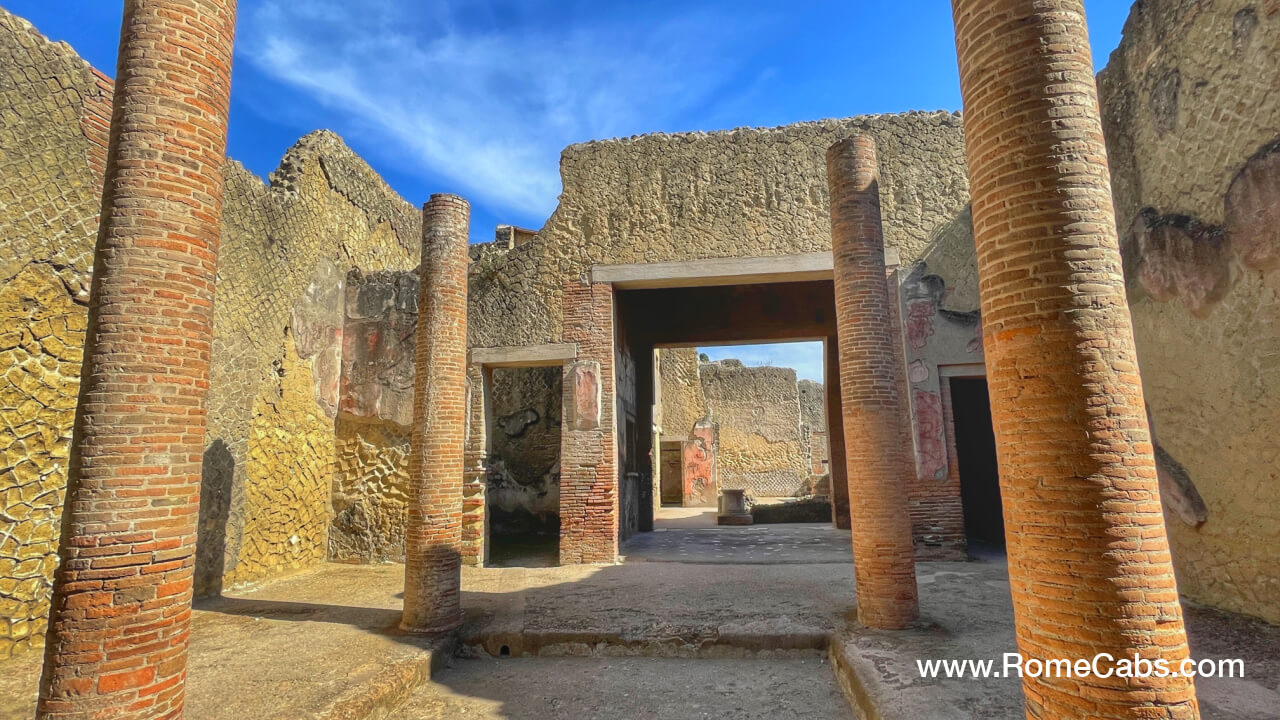
If you can’t decide between Herculaneum and Pompeii, we can take you to see BOTH sites in one day either on a Day Tour from Rome or Shore excursions from Naples.
You can visit Herculaneum together with Sorrento and Positano for a taste of the glorious southern region of Italy. We can also reserve a private tour guide for an informative 2-hour discovery walking tour of Herculaneum with a licensed, experienced, and knowledgeable local guide. Visit our website or contact us for more information on visiting Herculaneum from Rome or from the Cruise Port in Naples.
- ALSO READ:
5 Great reasons to book private tours in Italy
Rome in A Day – Top Must See Places in Rome
Visiting Rome in the Summer? Here's what to expect:
Thank you for reading our travel blog, and come back as we will continue to post more articles about Herculaneum, Pompeii, Positano, Sorrento and more!
We look forward to showing you beautiful places in Italy!
Find us online also on:
- RomeCabs FACEBOOK
- RomeCabs PINTEREST
- RomeCabs TWITTER
- RomeCabs INSTAGRAM
- RomeCabs FLICKR Photo Gallery
- Recommended on Cruise Critic
